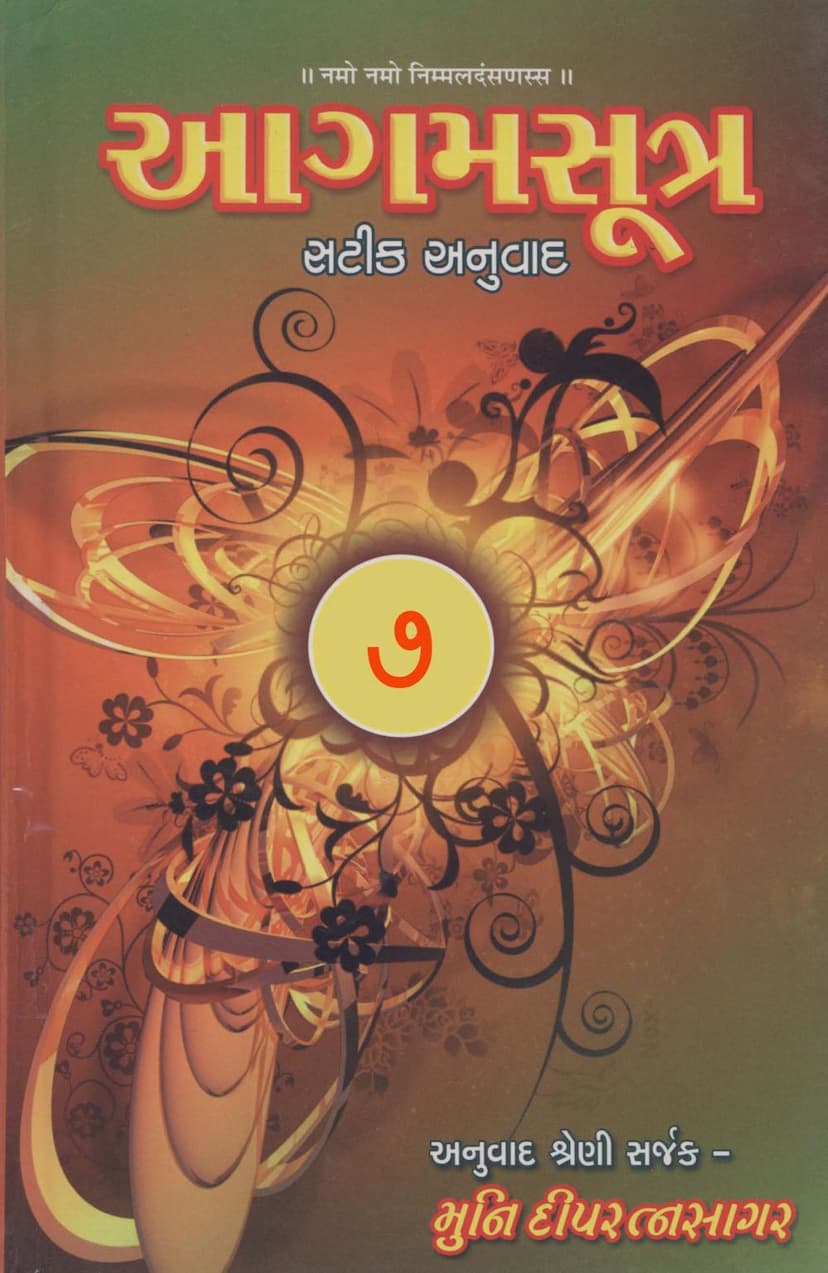Agam Satik Part 07 Sthananga Sutra Gujarati Anuwad 3
Added to library: September 1, 2025

Summary
This document appears to be a Gujarati translation and commentary of the Jain Agam text, the Sthānānga Sūtra, which is part of the Agam Satik series, specifically Volume 7. The provided text is a detailed breakdown of the Sthānānga Sūtra, covering chapters or sections that discuss various topics categorized by numbers, primarily "six" and "ten" (dasha).
Here's a breakdown of the content based on the provided pages:
-
Title & Authorship: The book is identified as "Agam Satik Part 07 Sthānanga Sutra Gujarati Anuwad 3" by Dipratnasagar (Deepratnasagar). The publisher is also Deepratnasagar. The catalog link is provided. It emphasizes Jain Education International for private and personal use.
-
Dedication & Acknowledgements: The text begins with salutations to various Jain spiritual figures and expresses gratitude to Acharya Shri Richakchandrasurishwarji and Acharya Shri Harshsagar Suriji for their inspiration and financial support, along with various Jain Sanghas and Trusts that contributed.
-
Core Content - Sthānānga Sūtra Commentary:
- The Sthānānga Sūtra is identified as the third Āgama and the seventh part of the Agam Satik translation series. It is divided into three parts (Parts 5, 6, and 7). This volume covers Sthānanga (Chapters/Sections) 6 through 10.
- The commentary provides a detailed verse-by-verse (sūtra) and section-by-section (vivechan) explanation.
- A significant portion of the text is dedicated to listing and explaining concepts that occur in tens (dasha). This includes:
- Ten types of moral conduct (āchāra): Discussed in relation to the Sthānānga Sūtra.
- Ten types of sins (pāpa): Explained in relation to the pāpakṛt (sinful actions).
- Ten types of righteous conduct (dharma): Such as ārambha (initiation) and its absence (anārambha).
- Ten types of samiti (careful conduct): Like iṛyāsamiti, bhāṣāsamiti, etc.
- Ten types of gupti (restraints): Related to mind, speech, and body.
- Ten types of delusions (mithyātva): Such as mistaking irreligious for religious, etc.
- Ten types of life forms (jīva): Including one-sensed to five-sensed beings.
- Ten types of rebirth destinations (gati): Such as hellish beings, animals, humans, gods.
- Ten types of karma: Such as knowledge-obscuring karma, perception-obscuring karma, etc.
- Ten types of sense objects (vishaya): Related to the five senses and mind.
- Ten types of offenses (aparādha) against spiritual teachers (āchārya): Discussed in the context of confession and penance.
- Ten types of ascetics (muni): Described in terms of their practices and conduct.
- Ten types of desires (saṅjñā): Such as food desire, fear desire, etc.
- Ten types of temptations (kleśa): Including krodha (anger), māna (pride), etc.
- Ten types of achievements (siddhi): Related to spiritual progress.
- Ten types of celestial beings (deva): Described in terms of their abodes and positions.
- Ten types of vows (vrata): The core ethical principles of Jainism.
- Ten types of states of existence (bhāva): Such as āyika, aupśamika, etc.
- Ten types of calamities (upaśarga): Experienced by ascetics.
- Ten types of speech (vachana): Categorized by their nature and intention.
- Ten types of faults (dosa): In conduct and speech.
- Ten types of correct understanding (samyakdarshan) and misconduct (mithyādarshan).
- Ten types of knowledge (jnāna): Such as mati, śruta, avadhi, etc.
- Ten types of penances (tapa): Both external and internal.
- Ten types of unions (samūha): Describing collectivities of beings.
- Ten types of auspicious dreams (mahāsvapna): Interpreted as omens of future spiritual status.
- Ten types of blessings (śubha): Associated with auspicious actions.
- Ten types of celestial abodes (vimāna): Describing the residences of various gods.
- Ten types of kingdoms and cities.
- Ten types of celestial armies and commanders.
- Ten types of cyclical time periods (yuga): Such as utsarpiṇī and avasarpiṇī.
- Ten types of musical notes (swara) and their association with celestial beings and their abodes.
- Ten types of professions or livelihoods (jivikā).
- Ten types of spiritual paths (mārga) or practices.
-
Publisher's Information: Pages include details about the publisher, contact information for "Agam Aradhana Kendra, Shitalnath Society, Ahmedabad," and printing details.
-
List of Publications: Several pages (Pages 8-22) are dedicated to listing and describing other publications by the same author/publisher, covering a wide range of Jain literature, including:
- Original Āgams
- Gujarati and Hindi translations of Āgams
- Commentaries (ṭīkā) on Āgams
- Dictionaries and indexes for Āgam texts
- Works on grammar, lectures, logic, rituals, worship, and devotional literature.
- A total of 301 publications are mentioned.
Overall Purpose:
This document serves as a Gujarati translation and detailed commentary of the Sthānānga Sūtra, a foundational Jain scripture. The commentary aims to elucidate the meaning and implications of the Sūtra, particularly focusing on various classifications and enumerations, often grouped into tens. The extensive list of other publications highlights the publisher's commitment to making Jain scriptures and related literature accessible. The text emphasizes the classification of phenomena into groups of ten, which is a characteristic of the Sthānānga Sūtra's structure.